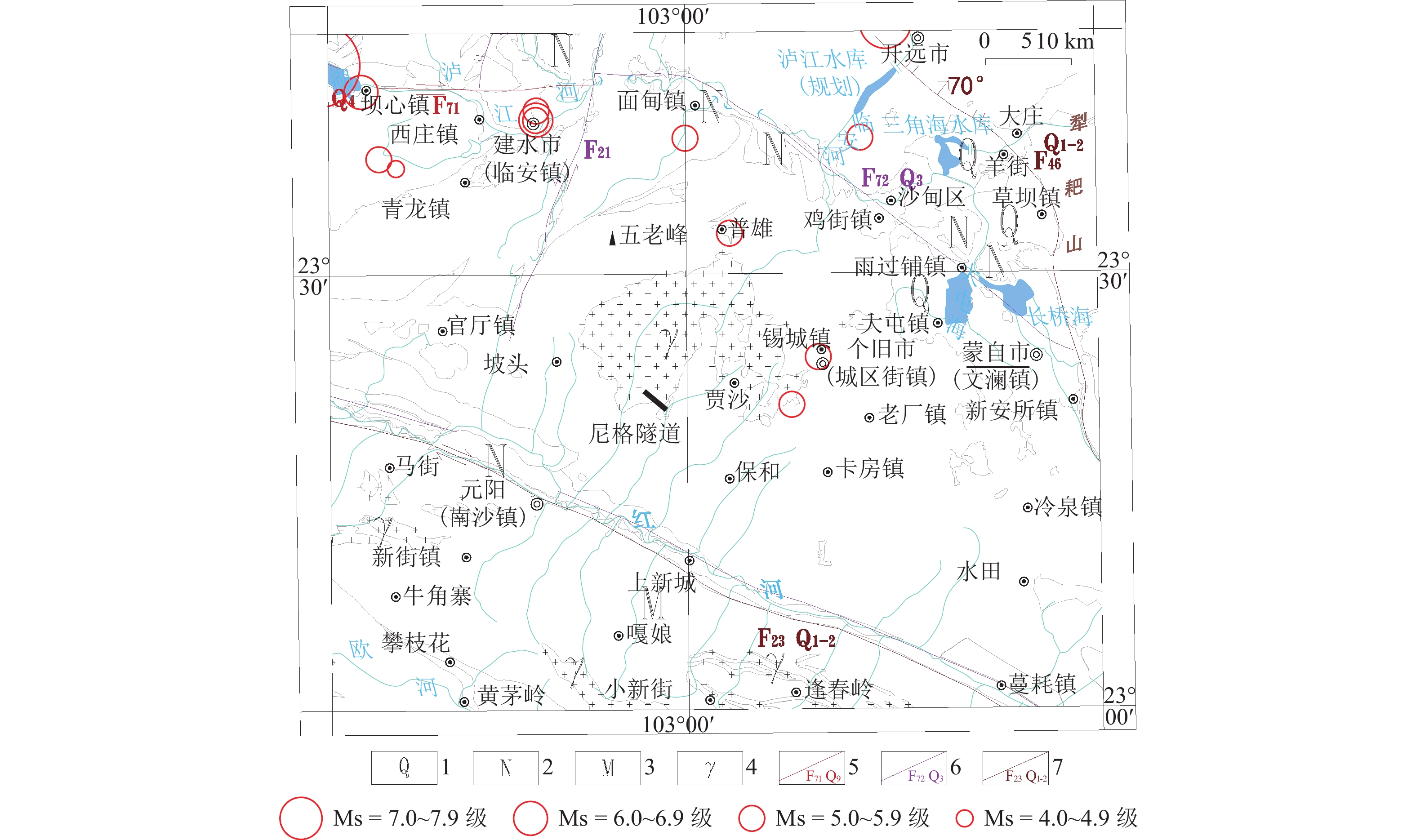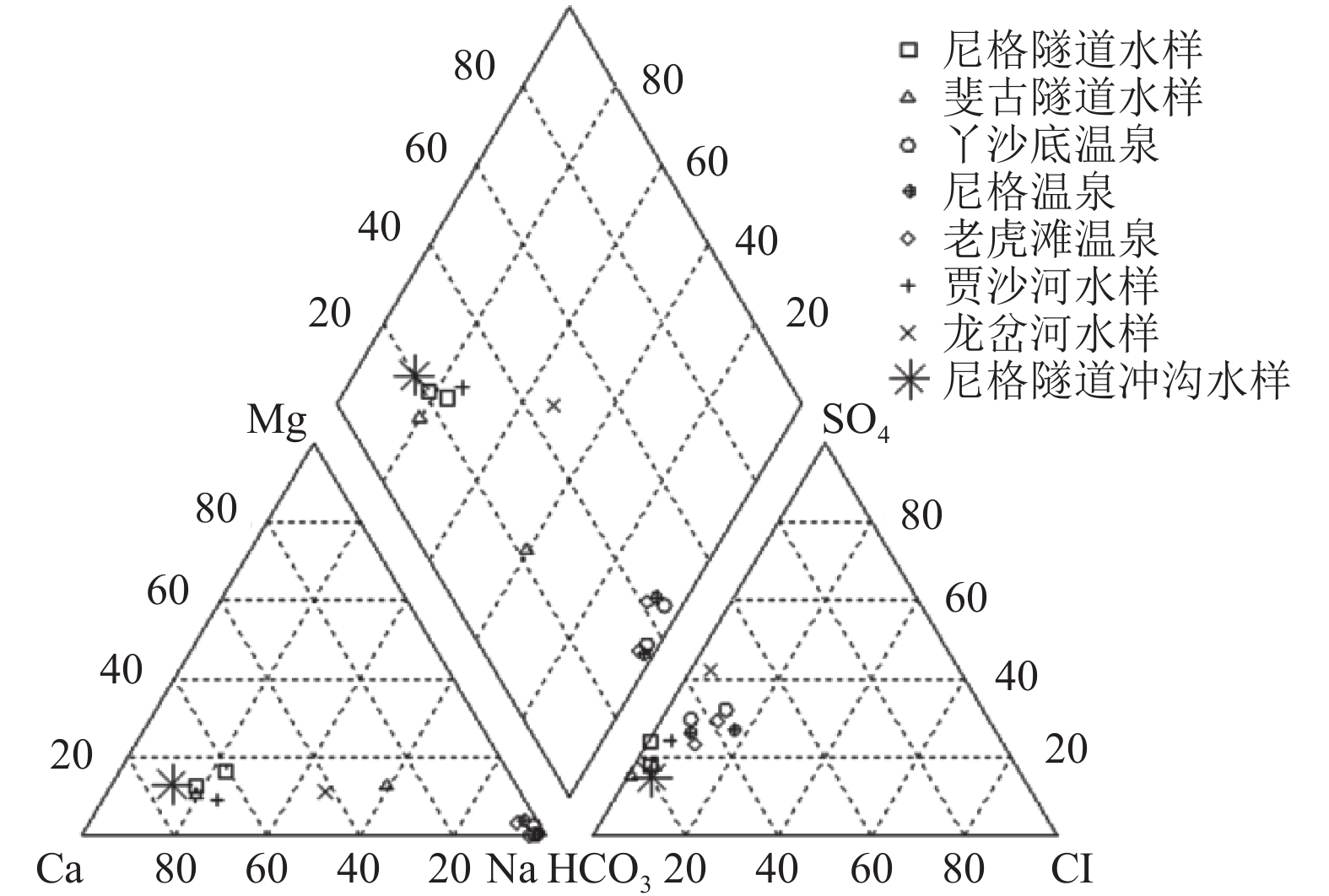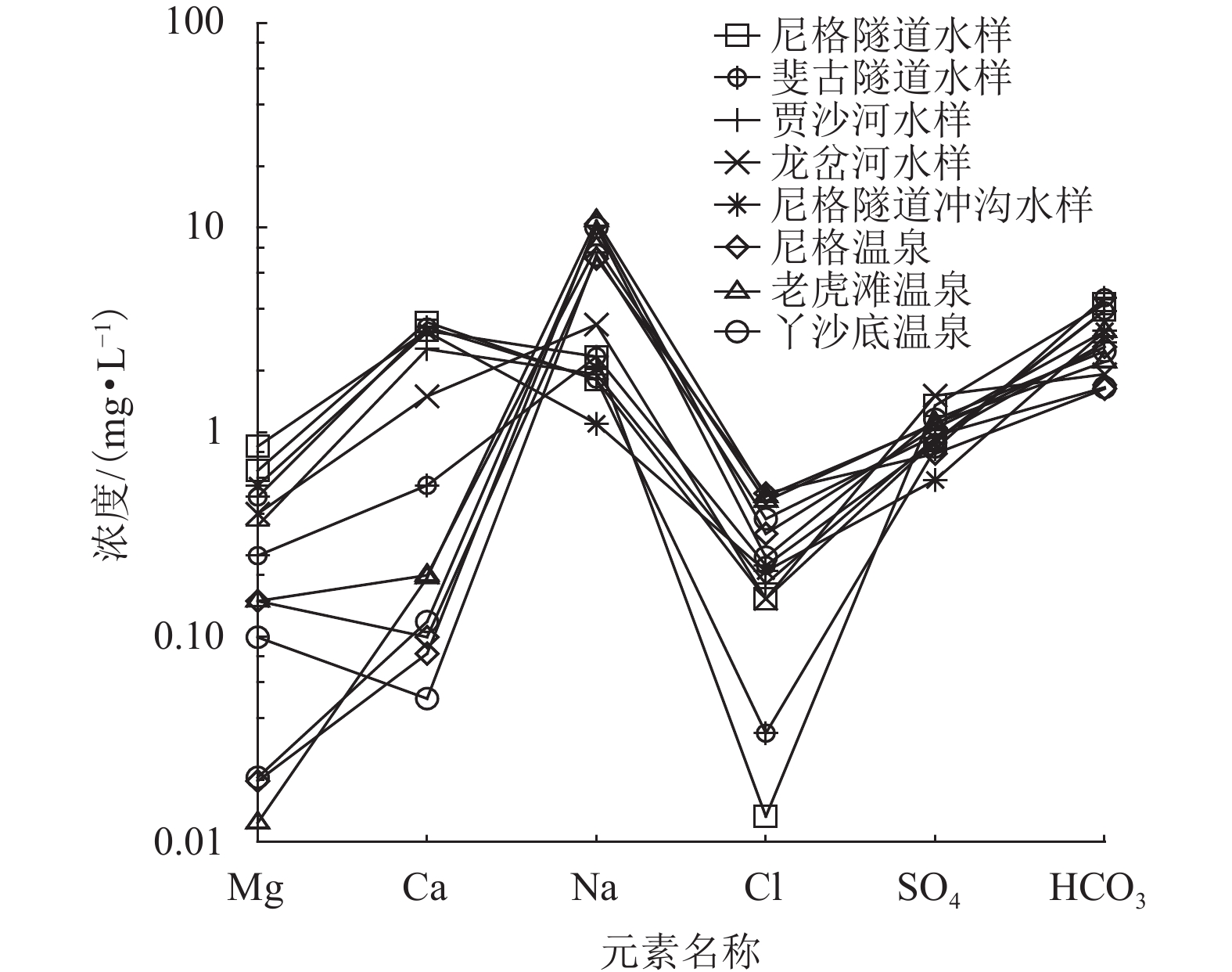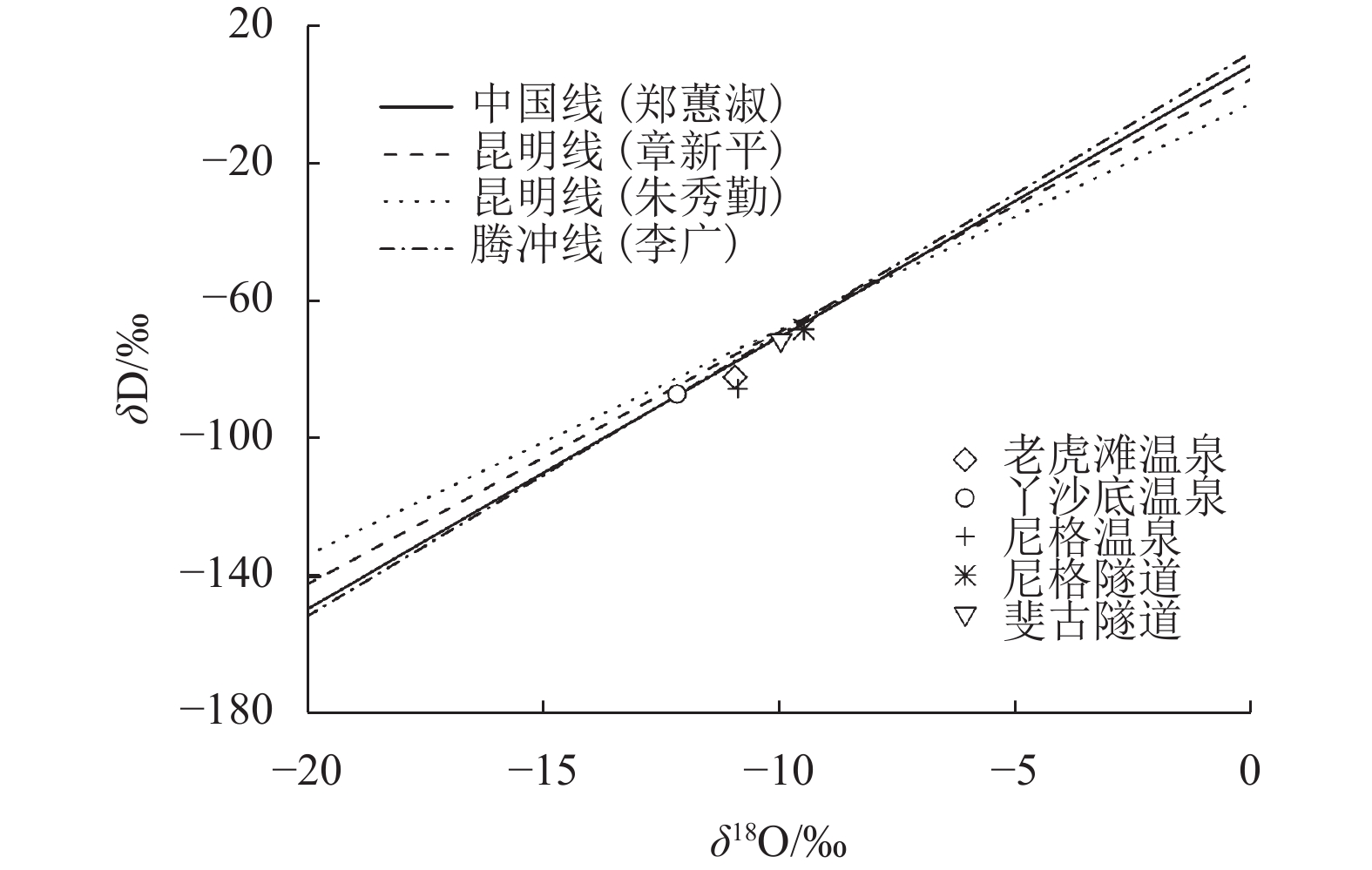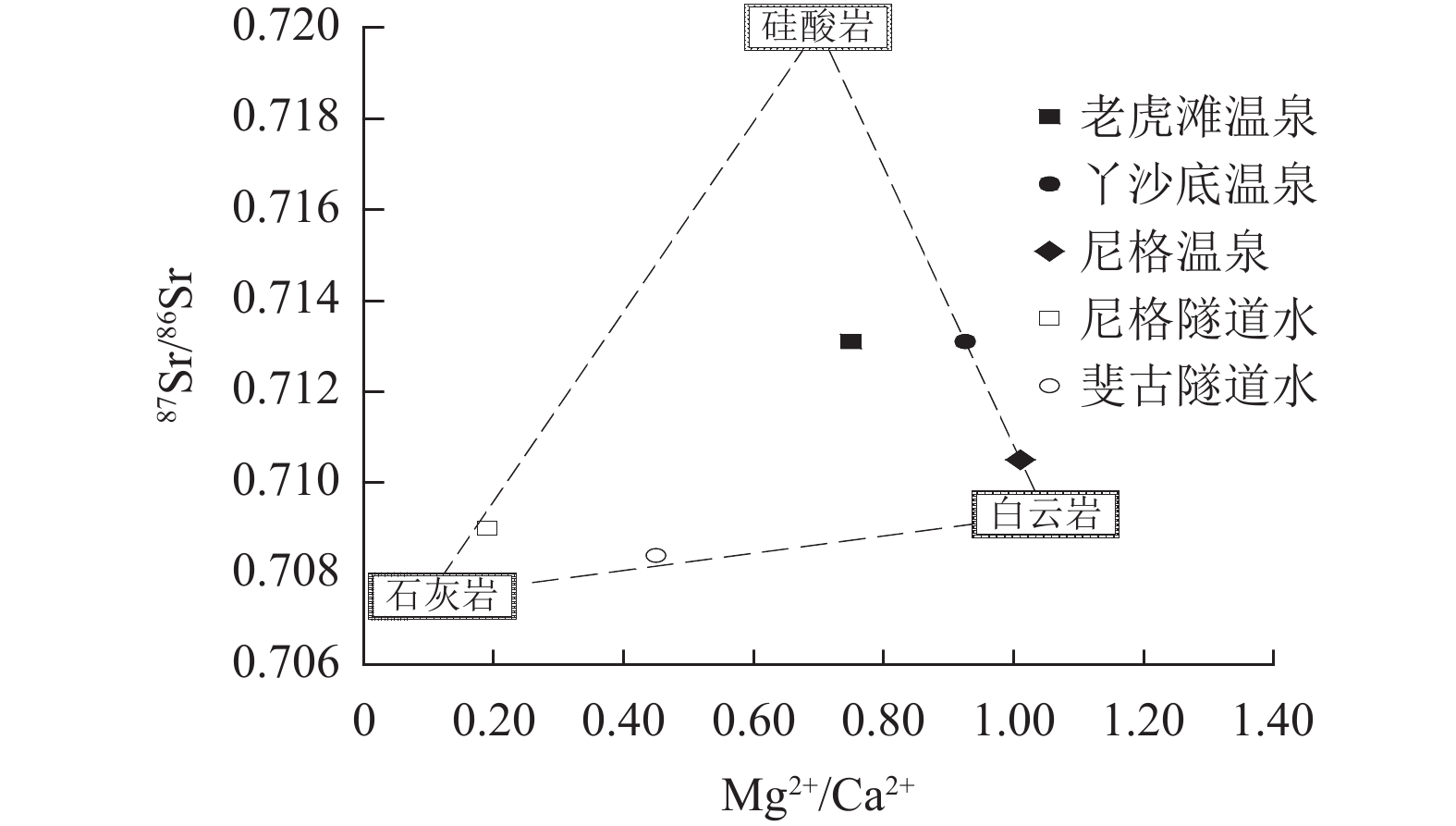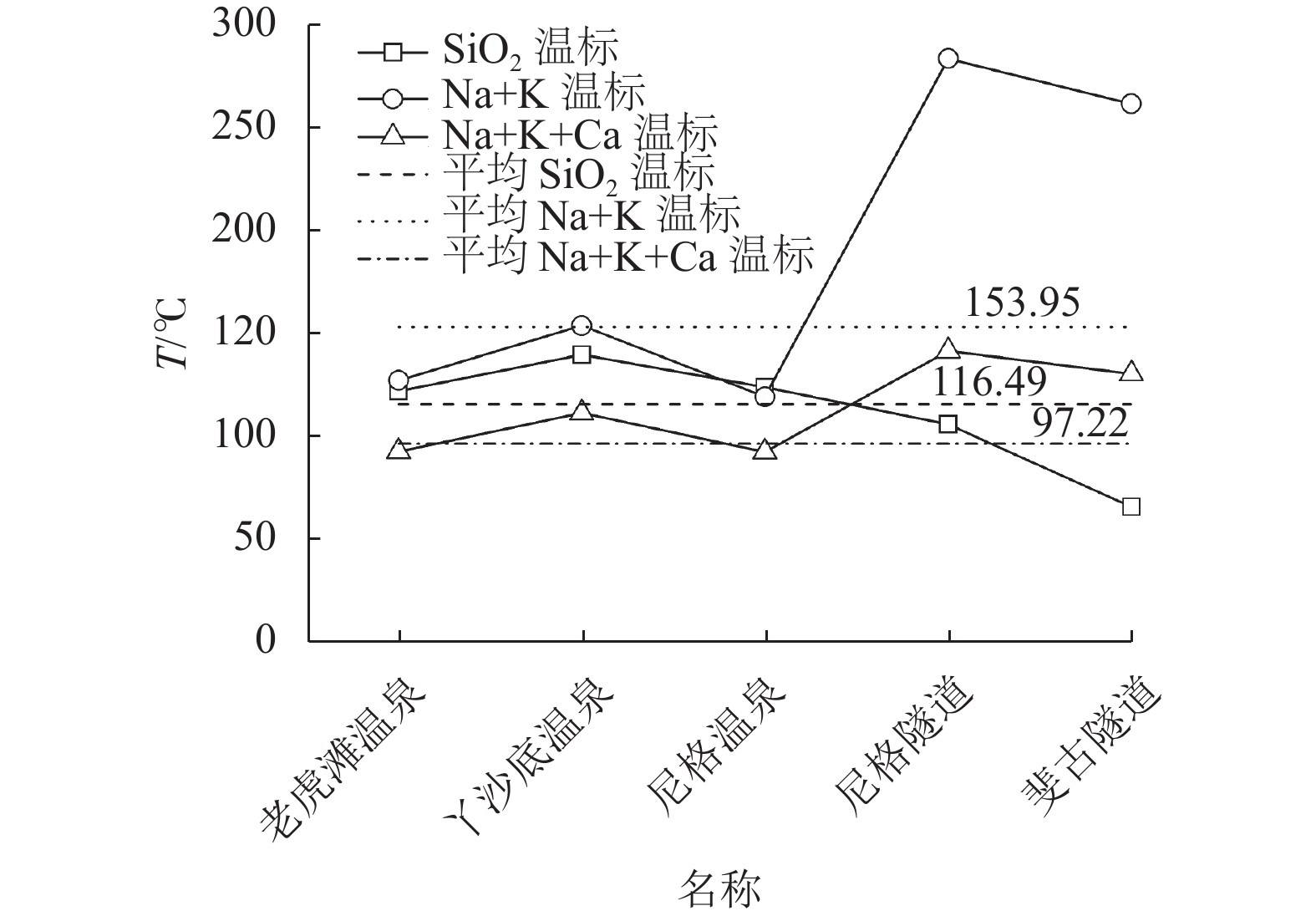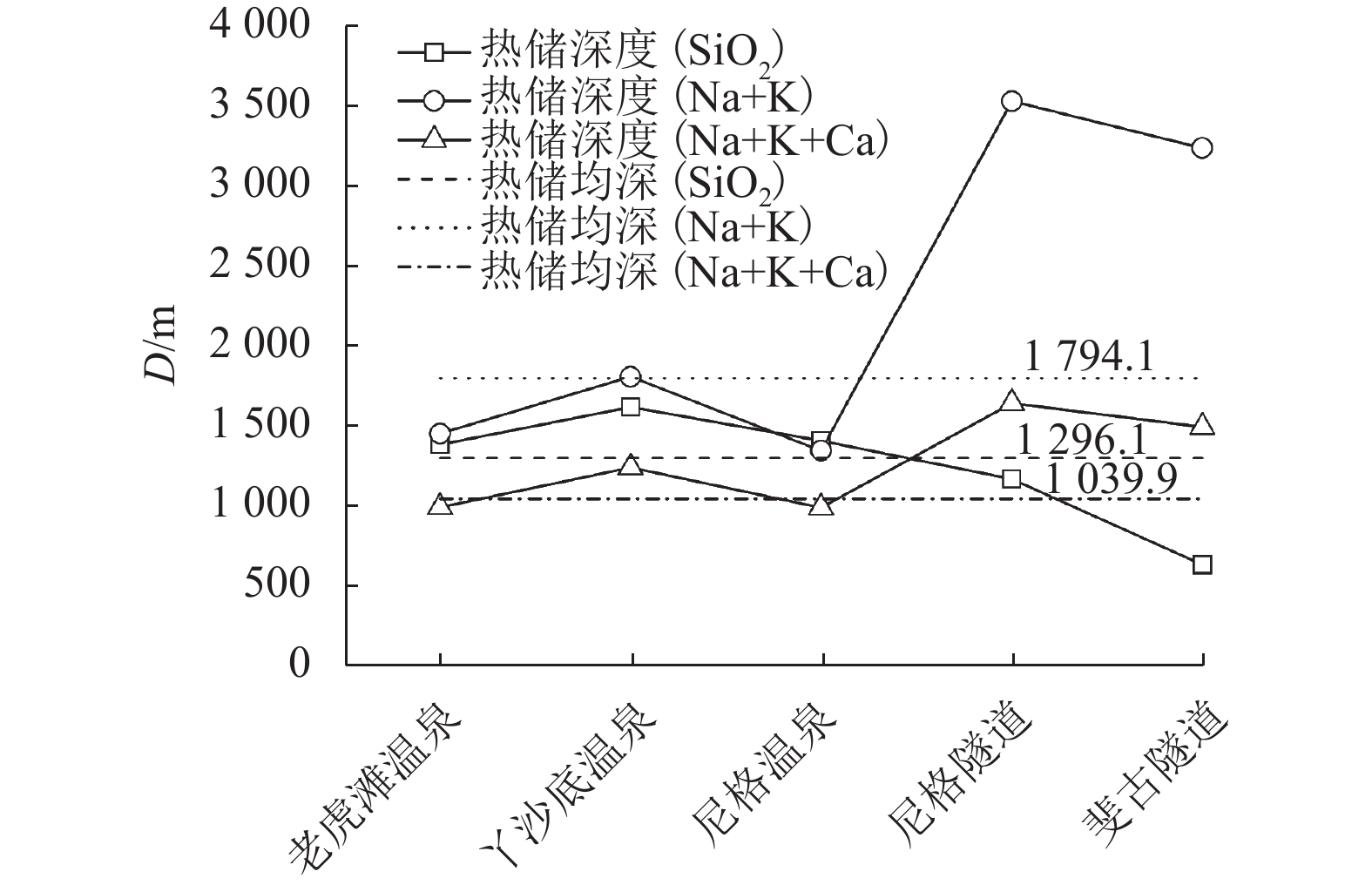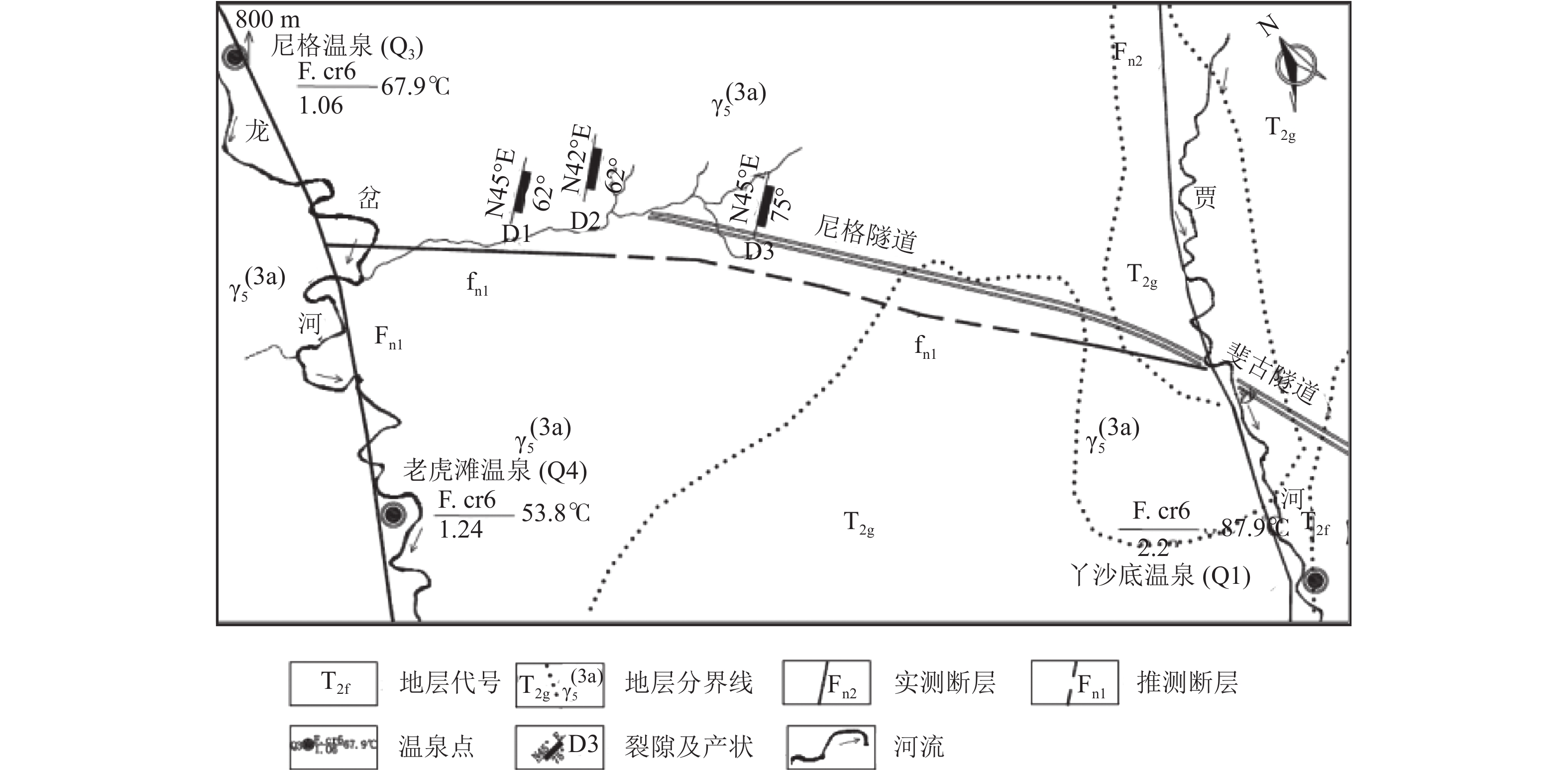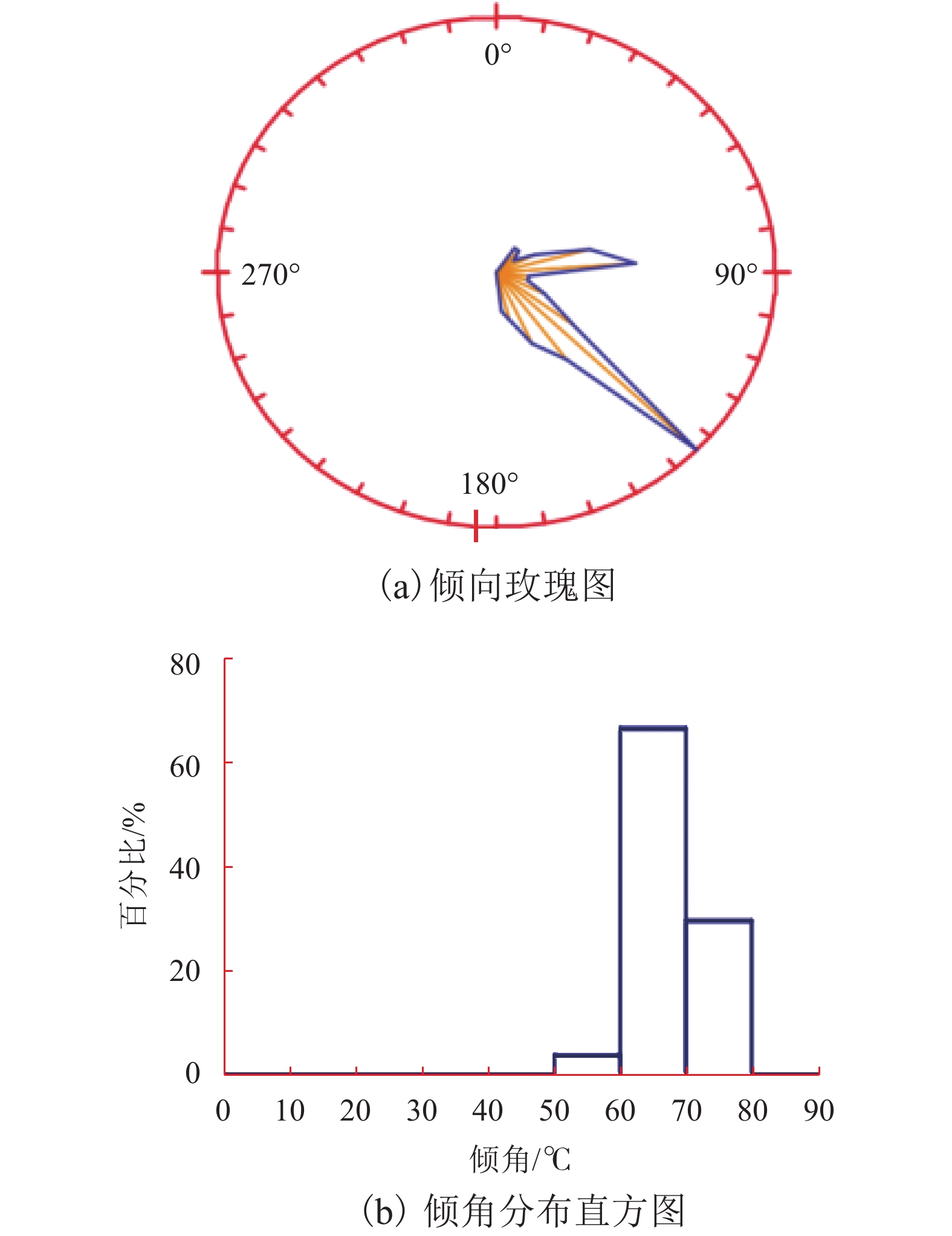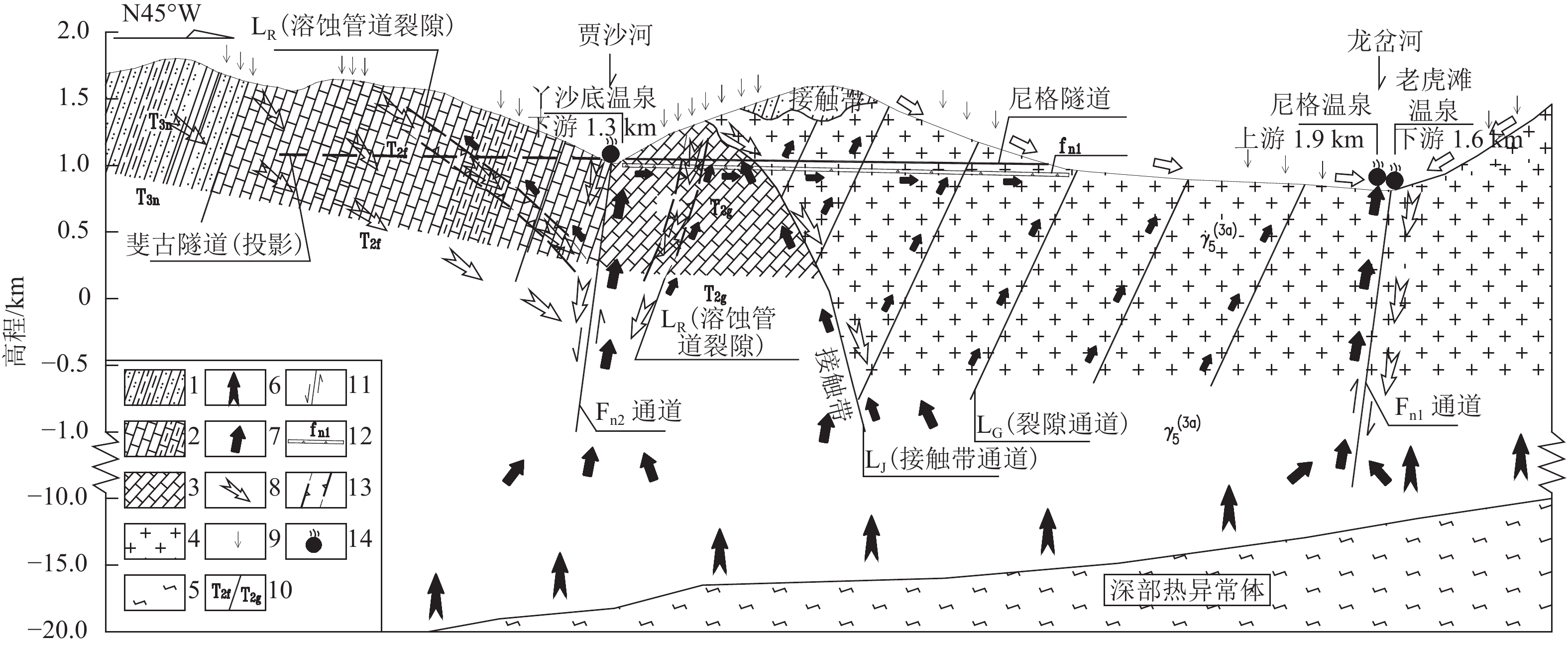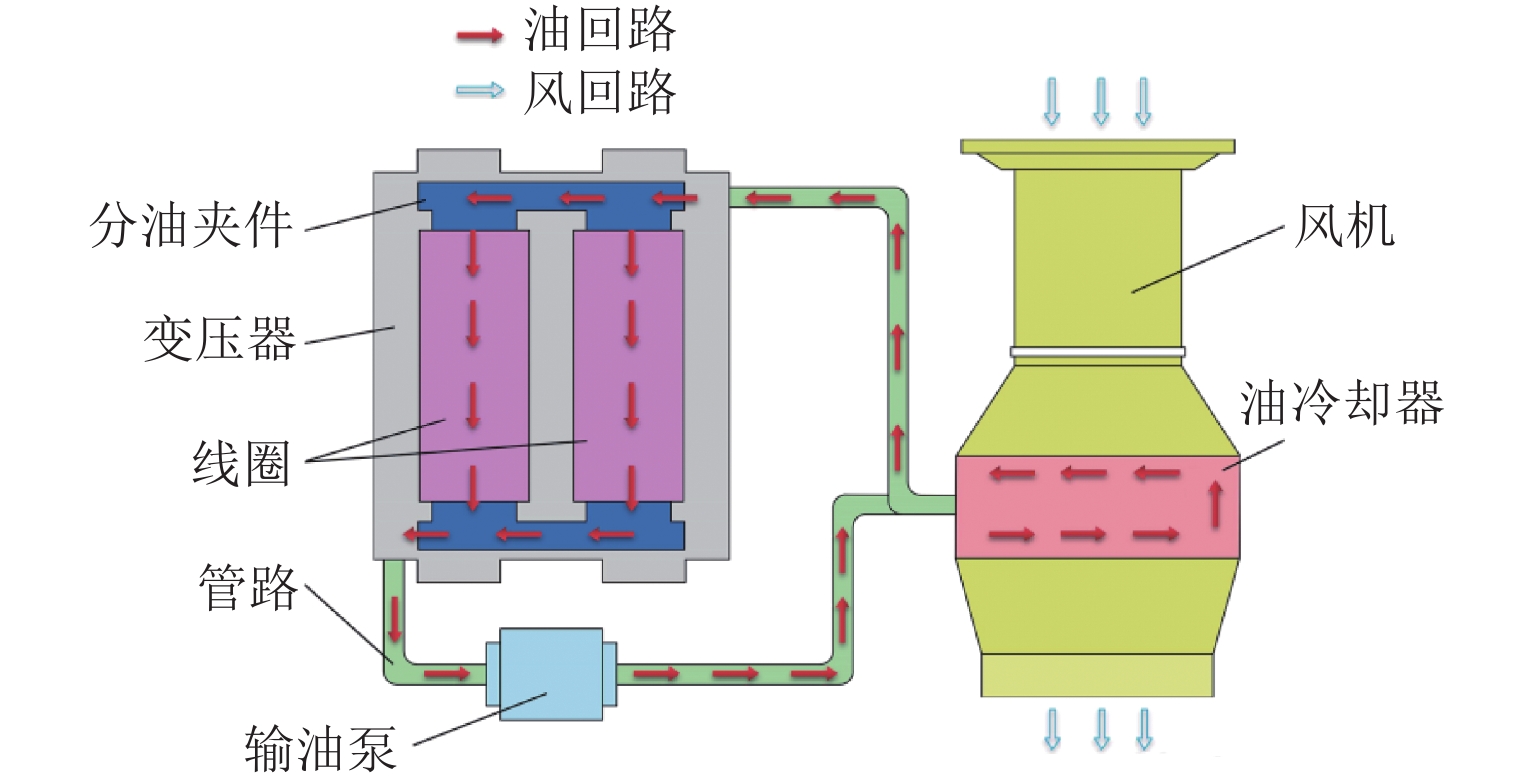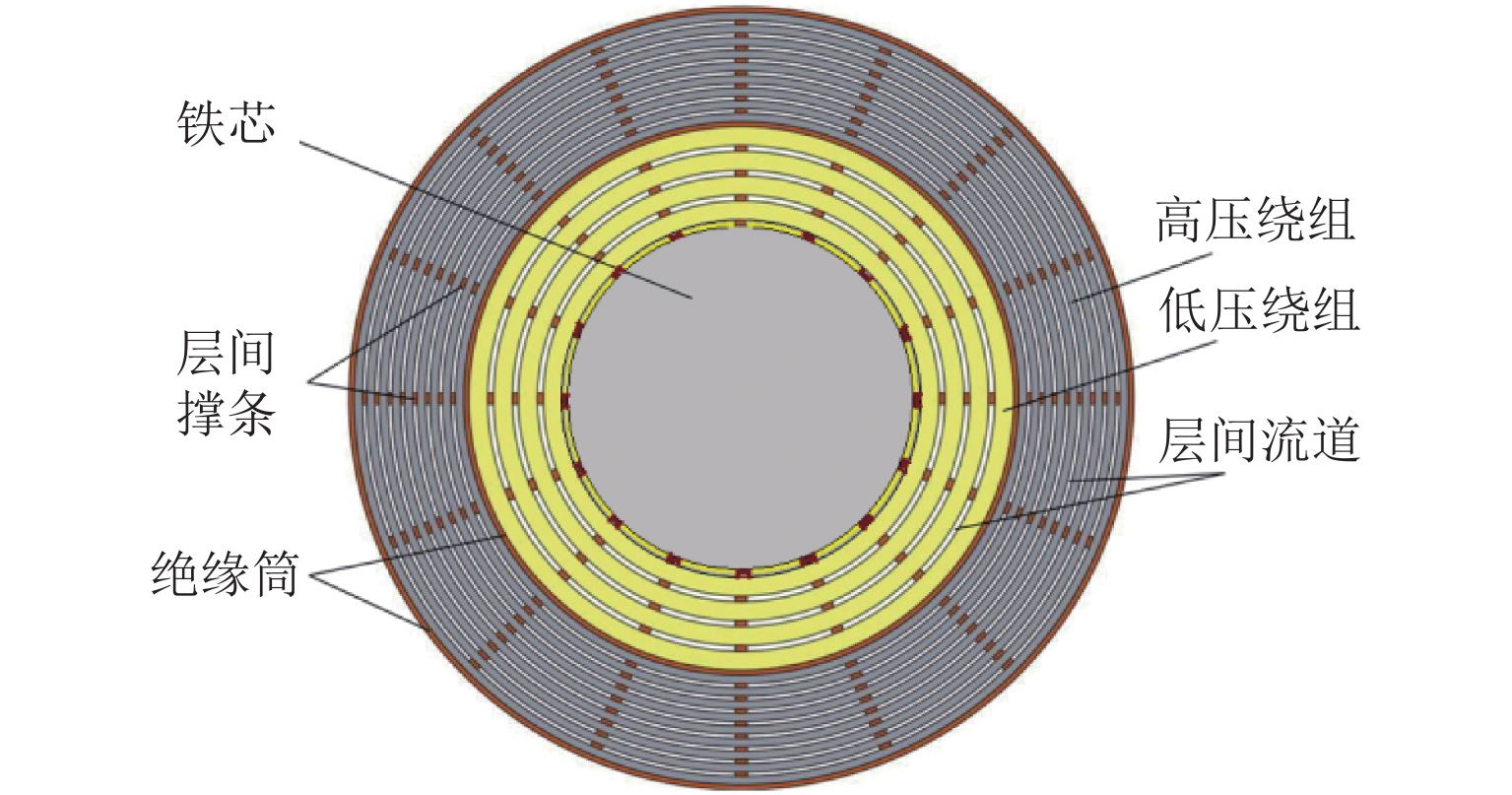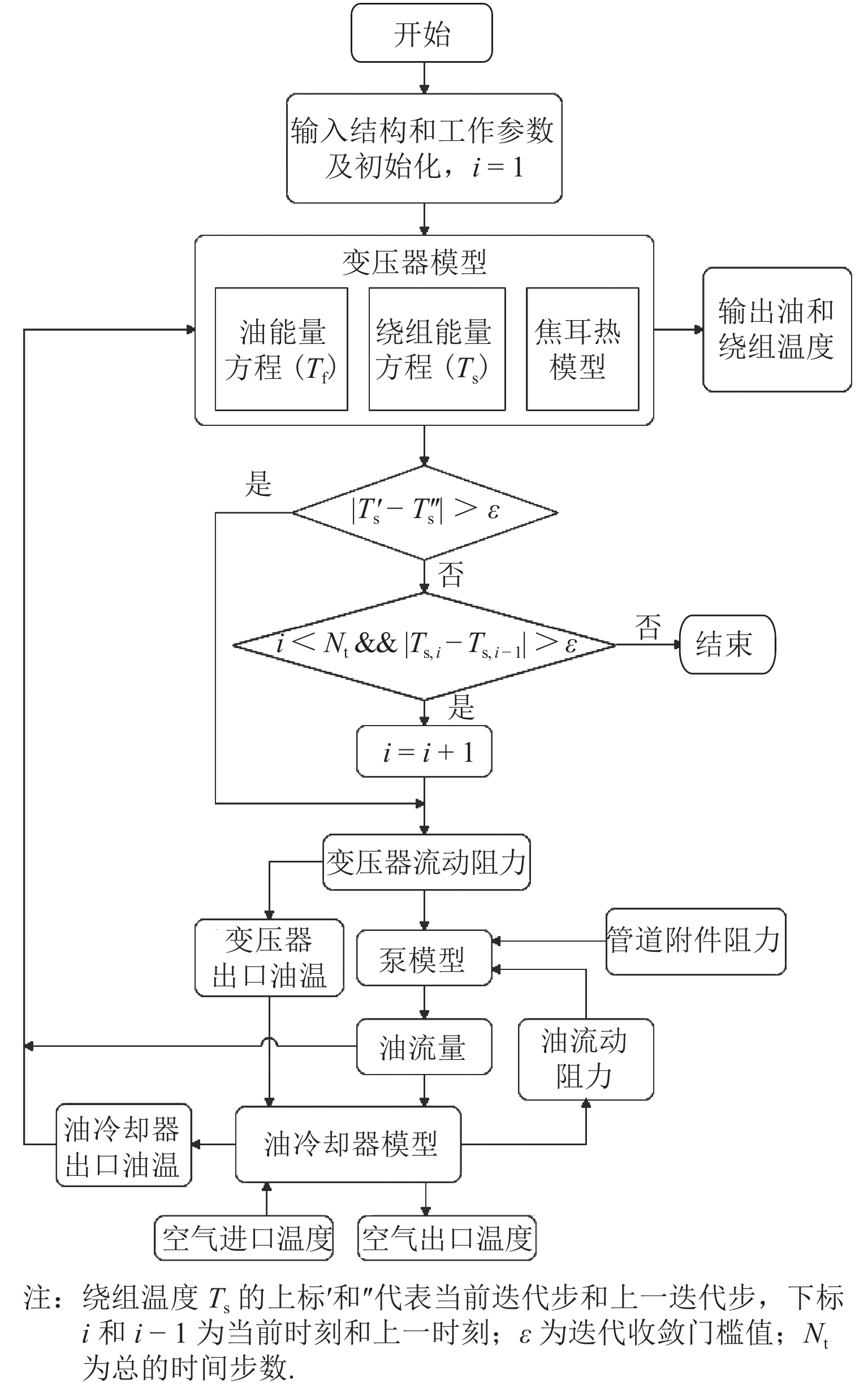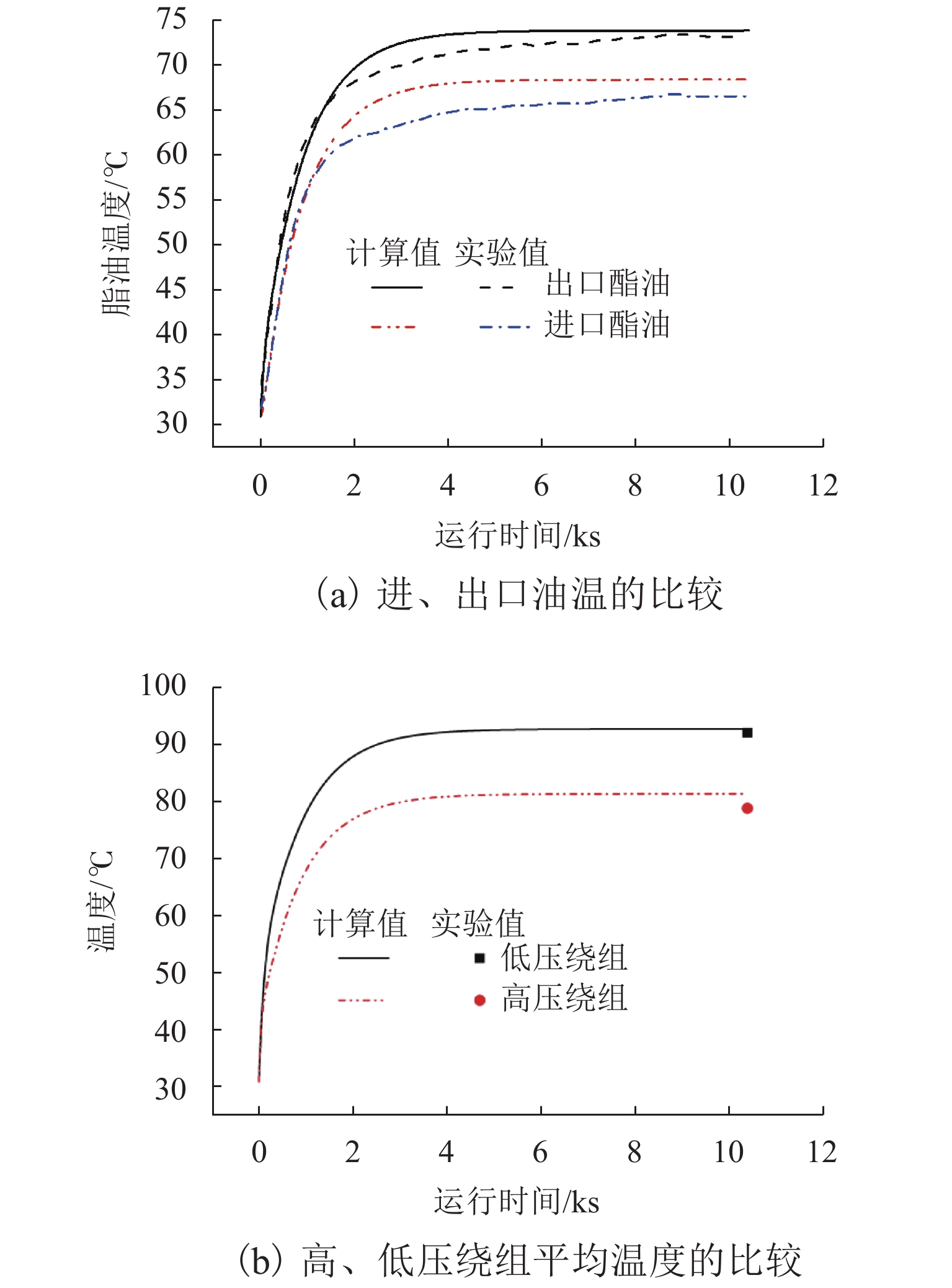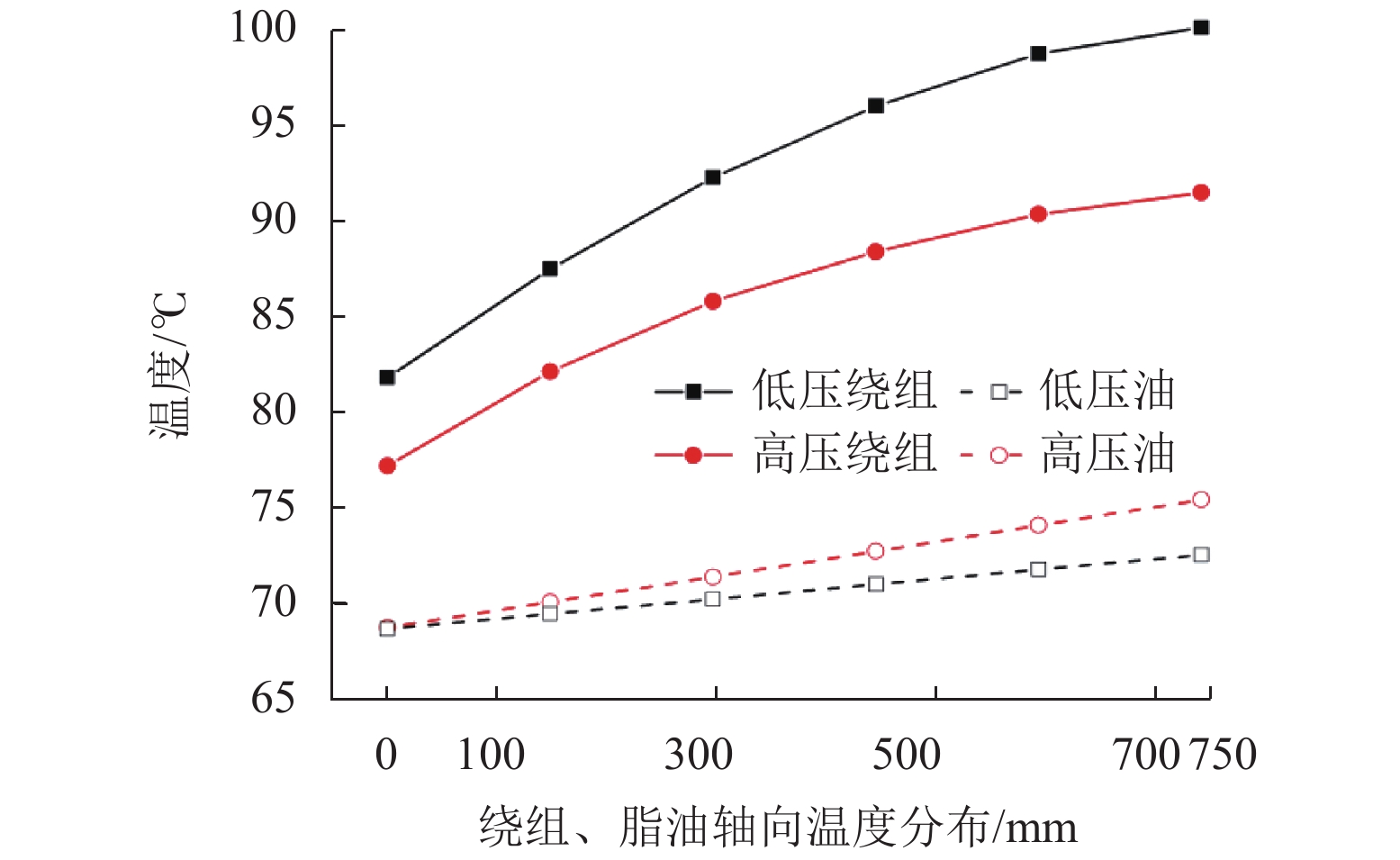Geological Genesis of Tunnel High Ground Temperature
-
摘要:
为研究隧道高地温的地质成因,以云南某在建高速公路隧道——尼格隧道为研究对象,该隧道兼有高水温与高岩温,最高水温达63.4 ℃,最高岩温达88.8 ℃. 从区域地质构造及地震特征、水化学特征、地热储特征等对区域性的热因控制、水源、热源、导热通道等进行了分析,利用氢氧同位素分析法、锶同位素分析法、微量元素分析法、放射性元素分析法等对隧址区的热水来源及演变过程、热源成因进行了研究,并结合隧道工程地质、水文地质条件及开挖揭示状况,对隧道高水温段及高岩温段的地质成因过程进行了剖析. 研究结果表明:灰岩段高水温的成因过程与花岗岩段高岩温有所差异,隧道高水温的成因过程为热源(深部热异常体)—主要传热通道(深循环)—次级传热通道—浅表水体混合、水岩作用,其过程伴随着冷热水混合作用、离子交换作用等;隧道高岩温的成因过程为热源(深部热异常体、放射性元素衰变生热)—主要传热通道(深循环)—次级传热通道—热气沿裂隙传至隧道岩体,其过程伴随着S元素的富集,易形成H2S或SO2有毒有害气囊.
Abstract:A highway tunnel under construction in Honghe Prefecture, Yunnan Province was taken as the research object to study the geological genesis of high ground temperature. The tunnel has both high water temperature and high rock temperature, with the maximum water temperature of 63.4 ℃ and the maximum rock temperature of 88.8 ℃. The regional thermal control, water source, heat source, and heat conduction channel are analyzed from the aspects of regional geological structure, seismic characteristics, hydrochemical characteristics, and geothermal reservoir characteristics. The hot water source, evolution process, and origin of heat source are studied by means of hydrogen oxygen isotope analysis, strontium isotope analysis, trace element analysis, and radioactive element analysis. Based on the geological, hydrogeological and excavation conditions of the tunnel, the geological genesis of the high water temperature section and the high rock temperature section of the tunnel is dissected and discussed. The results show that the genetic process of high water temperature in limestone sections is different from that in granite sections. The genetic process of high water temperature in tunnel is “heat source (deep thermal anomaly)–main heat transfer channel (deep cycle)–secondary heat transfer channel–shallow water mixing and water rock interaction”, which is accompanied by cold and hot water mixing, ion exchange, etc.; while the genetic process of high rock temperature in tunnel is “heat source (deep abnormal body, radioactive element decay heat generation)–main heat transfer channel (deep cycle)–secondary heat transfer channel–hot gas being transmitted to the tunnel rock mass along the crack”, and the process is accompanied by the enrichment of S element, which is favorable to the formation of toxic and harmful air bag of H2S or SO2.
-
与内燃机车相比,电力机车运输能力更强、综合性能也更优越,广泛应用于干线铁路运营和城市轨道交通[1]. 电力动车组将动力装置分散到各节车厢,可以达到更高的运营速度,近10多年来在我国得到了快速发展. 牵引变压器负责向动力装置提供电能,关系到列车运行安全,是动车组关键技术之一[2]. 相比于传统电力变压器,动车组牵引变压器发热功率大、运行条件恶劣、内部绕组容易过热[3]. 变压器绕组过热会加速绝缘材料老化,严重时,甚至烧损绝缘材料、引起短路停车事故. 热电类比常用来计算变压器工作温度,采用集中总参数分析方法,分别建立绕组和油的等效电路及相应的微分方程. IEEE Std C57.91—2011导则给出了基于热电类比的变压器绕组温升计算模型[4]. Swift等[5-6]考虑环境温度变化对变压器散热性能的影响,对导则中的热电类比分析模型进行了改进,实验表明,改进后的模型可以比较准确地预测变压器顶层油温升. 为考虑油黏度随温度变化的影响,滕黎等[7]建立变压器热电类比模型时定义了非线性热阻和集总热容. 热电类比法计算简便,但没有充分考虑变压器绕组和油温度在空间分布上的差异. 另外,变压器启动阶段,油流量不断增加,可能对变压器的温升特性产生显著影响. 随着数值传热学和计算机技术的快速发展,计算流体动力学(CFD)技术逐渐进入了变压器热特性研究领域[8-12]. 这类方法通过求解流场和温度场控制微分方程组,获得变压器内部绕组和油温度分布情况. 陈伟根等[8]采用控制体积方法对油自然循环的电力变压器进行数值模拟,预测了稳态条件下绕组温度分布情况;谢蓉等[10]利用商业CFD软件ANSYS Fluent建立了强迫油循环冷却的变压器流固耦合传热的数值模型,并研究了进出口位置、进口速度和导向结构对冷却效果的影响;Torriano等[11]利用商业Fluent软件研究了质量流量和进口条件对盘式绕组内部流动和温度的影响. CFD技术可以比较准确地预测变压器内部流场和温度场,进而替代和削减物理实验,但计算量大,不太适合做非稳态计算,对复杂多设备散热系统的适应性也不强.
牵引变压器发热功率很大,需要采用强迫油循环风冷的方式进行散热. 对这种散热方式进行数值模拟,除了要求解变压器内部油与绕组间复杂流固耦合传热外,还需要考虑高温油通过油泵输送到换热器的二次冷却. 基于已有的分析,本文拟将变压器(含绕组和油)、油冷却器、油泵和管道等看做一个完整系统,对变压器和油冷却器分别做一维假设,建立强油循环风冷变压器散热系统的数学模型,并提出合适的算法进行数值求解. 鉴于动车组运行时牵引变压器温度随时间、空间显著变化,笔者拟借助该数值模型研究变压器动态温度场特性. 为了检验模型的预测精度,本文以一台车载牵引变压器及其配套散热系统进行动态温升实验.
1. 数学模型
1.1 物理模型
某型牵引变压器绕组焦耳热比较大,为防止其温度过高,采用强迫油循环风冷方式进行散热. 该变压器散热系统工作原理如图1,由变压器(内含2个线圈柱)、油泵、油冷却器、风机、管道和冷却油等组成. 工作时,冷却油在油泵驱动下,进入绕组内部油道进行冷却;吸热后的高温油经管道流入油冷却器,被常温空气所冷却;降温后的冷却油再次进入变压器构成循环.
该变压器线圈柱采用层式结构,低压绕组在里侧,外侧为高压绕组,如图2所示. 鉴于高压和低压绕组的结构和工作参数相差较大,本模型对其单独建模,两绕组的冷却油在变压器出口处混合.
1.2 控制方程组
牵引变压器工作时,冷却油不断流过绕组层间狭缝流道,吸收绕组工作损耗所释放的热量. 这一过程可以抽象为带固体内热源的平行通道流固耦合传热问题. 考虑到铜线绕组热导率很大,单层绕组厚度又比较小,可以忽略垂直于油流动方向温度梯度,因此,采用一维空间流体(冷却油)和固体(绕组)双能量方程来描述 [13-14],如式(1)、(2).
ρfcp,f∂Tf∂t+ρfucp,f∂Tf∂x=kf∂2Tf∂x2+αas(Ts−Tf), (1) ρscp,s∂Ts∂t=ks∂2Ts∂x2+αas(Tf−Ts)+SJH, (2) 式中:u为流体速度;t和x分别为时间和绕组轴向位移;ρ、cp、k和T依次为密度、比热、热导率和温度,下标f和s分别表示流体和固体;as为比表面积;α为油与绕组间对流传热系数,由经验关联式确定[14]; SJH为绕组运行的焦耳热,与工作电流和导线截面积等有关,数值由焦耳定律确定.
为了考虑换热面和液体热容对变压器动态温度场特性的影响,油冷却器传热模型包括固体换热面及其两侧流体(冷却油和空气)的非稳态能量守恒方程. 与变压器模型类似,油冷却器也采用一维非稳态模型,即冷热流体能量方程形式与式(1)相同,固体换热面的微分方程与式(2)类似,但需要同时考虑两侧表面的对流传热,另外,其内部无内热源项(即无右侧第3项).
变压器油流量与油泵供油特性有关,还依赖于油泵实际工作扬程. 油泵工作扬程等于变压器、油冷却器和管道等流动阻力之和,变压器与油冷却器的流动阻力Δp用式(3)计算,管道油流阻力还需考虑局部损失的影响[15].
Δp=fLρu22Dh, (3) 式中:L和Dh分别为流道长度和特征尺寸;f为摩擦因子,由经验关联式确定.
油冷却器采用板翅式结构,空气侧采用波纹翅片,油侧采用锯齿形翅片. 数值求解油冷却器能量微分方程时,首先按冷却器结构和工作参数确定空气侧和油侧的雷诺数(Re数),然后采用j因子和f因子关联式(式(4)~(7))确定α和
$\Delta p $ .空气侧波纹翅片(1000 < Re < 15000)[15-16]:
f=10.628Re−0.359(H/s)0.264(2A/s)−0.848(l/2A)−1.931, (4) j=0.242Re−0.375(H/s)0.235(2A/s)−0.288(l/2A)−0.553, (5) 式中:H、s分别为翅片高度、间距; A和l分别为波纹波幅、波长.
油侧锯齿翅片(300 < Re < 7500)[16-17]:
lnf=0.132856(lnRe)2−2.28042lnRe+6.79634, (6) lnj=−0.0264136(lnRe)3+0.555843(lnRe)2−4.09241lnRe+6.21681. (7) 高、低压绕组结构尺寸和工作电流有显著差异,其传热特性明显不同,为提高预测精度,分别对高、低压区绕组和油的能量方程进行离散. 根据层间油道并联的特点,按照高压和低压绕组油道流动阻力相等的原则来分配两者油流量.
2. 数值求解
强迫油循环风冷变压器散热的数值模型由变压器、油泵、油冷却器和管道等模块组成. 这些模块通过进出口压力、温度和流量连续耦合在一起,借助迭代计算进行数值求解. 变压器和油冷却器采用分布参数,数值计算时,沿油流方向离散成若干单元,并采用有限差分法将其控制微分方程组(即式(1)、式(2))转变为代数方程组. 方程离散时,空间导数采用中心差分格式,时间维度采用全隐格式. 在MATLAB平台上进行数值计算,采用稀疏矩阵方法求解代数方程组.
图3为牵引变压器散热数值计算流程框图. 求解过程由内、外两个循环组成:内循环用于计算当前时刻变压器(含冷却油和绕组)温度和流阻、油冷却器油温和流阻、油泵流量等参数,由于冷却油黏度和绕组电阻等参数与温度密切相关,内循环通过迭代计算确定绕组内热源和油泵流量;外循环为时间域循环,用于模拟变压器和油冷却器温度场和油循环流量等参数随时间的变化. 通过比较相邻时刻温度相对变化量来判断散热过程是否进入稳态工况,一旦进入稳定工况,输出计算结果并终止程序.
3. 变压器温升实验与模型验证
3.1 变压器温升实验
为验证本文变压器散热模型的准确性,搭建了变压器温升实验平台,对一台牵引变压器在典型工况下进行了测试,如图4所示. 实验平台包括一台牵引变压器样机及其强油循环风冷散热系统、供电系统、数据监测采集系统等. 变压器高、低压绕组均采用层式结构,轴向长度约为750 mm. 低压和高压绕组铜导线额定电流分别为966 A和147 A,额定工况发热密度约为0.82 MW/m3和1.40 MW/m3. 变压器进口和出口设置了油温探头,以便实时监测变压器工作时油温变化情况,同时依据断电时刻直流电阻值来推断绕组平均温度. 实验开始时,变压器内部温度与环境温度相同,约为31.2 ℃. 通电后,数据采集系统自动监测记录变压器各监测点数据. 连续运行3 h左右,系统温度达到稳定并已持续一段时间,停止实验.
3.2 模型验证
采用1.2节建立的变压器散热模型对牵引变压器动态温升实验进行数值模拟,并将模型预测的变压器进、出口油温度变化情况与实验值进行对比,如图5(a)所示. 从图5(a)曲线可以看出:高压绕组和低压绕组出口油温呈现同样的变化趋势,即通电初始阶段(约27 min),油温度急剧上升,随后油温上升速度显著减慢,最后趋于稳定. 出口油温的变化规律与变压器内部非稳态传热和油冷却器中油二次散热有关,即在变压器初始运行阶段,由于油温度较低、黏度较大,油泵工作扬程较大、流量较小,因此,在相同绕组发热量条件下,绕组和油温度上升都比较快;另一方面,在初始阶段,油流量较少,且油与空气间温差较小,油冷却器中油-空气换热量较少,因此,油从绕组获得的热量不能及时散发到大气中,导致油和绕组温度快速上升. 运转一段时间后,油温度已经显著上升,其黏度明显下降,此时,油流量较大,绕组能够得到有效冷却,同时由于油冷却器内传热也显著变强,油从绕组得到的热量能够及时排放大气,因而油和绕组温度上升速度明显减慢,最终趋于稳定. 对比图5(a)中温度曲线可以看出:本文模型预测的变压器进、出口油温曲线与实验值吻合较好,稳定运行的误差分别为1.8 ℃和0.7 ℃,整个动态过程的最大误差小于5.0 ℃,能够满足工程实践需求;本文预测的油温稳定时间(与稳定后温度相差1.0 ℃所需运行时间)与实验值接近,即58 min和61 min.
绕组断电时刻直流电阻反推高压和低压绕组平均温度数值见图5(b)右上角数值点. 为便于与实验值进行比较,对变压器模型计算的高、低压绕组温度场分别做平均处理,并将其随时间的变化情况绘于图5(b)中. 从图5(b)看出:变压器初始运行阶段,绕组温度快速升高,经过一段时间后温度上升速度显著减慢,最后趋于稳定. 显然,由于绕组发热量需要通过油带走,绕组温度上述变化规律与图5(a)中进、出口油温变化曲线一致. 定量比较图5(b)中稳态条件下高、低压绕组温度的模型预测值与实验值可以看出:两者比较接近,相对误差分别为3.2% 和0.6%.
为方便读者参考,表1总结了模型预测油温和绕组温度的实验测量值与预测值的相对大小.
表 1 油和绕组稳态温度预测值与实验值的对比Table 1. Comparison of oil and winding temperatures of current model against experimental counterparts参数 进口油温/℃ 出口油温/℃ 稳定时间/min 高压绕组温度/℃ 低压绕组温度/℃ 模型预测值 68.5 73.9 58 81.4 92.7 实验值 66.7 73.2 61 78.9 92.1 偏差 1.8 0.7 −3 2.5 0.6 上述对比分析表明:本文强迫油循环风冷变压器散热模型具有较好的预测精度,可以用于牵引变压器动态温度场研究.
4. 变压器温度场分析
为进一步了解变压器内部温度情况,图6给出了典型时刻高压和低压绕组以及相应流道内油温度沿轴向的分布曲线,横坐标0和750分别代表绕组线柱底部和顶部. 由于低温油从线圈柱底部进入绕组层间流道,吸收绕组损耗热后从顶部流出,因此油温度沿绕组轴向不断升高;另一方面,随着轴向油温的升高,油冷却能力变弱,为此绕组温度也会沿轴向不断增加,与图6温度曲线一致. 铜导线电阻值随温度升高而增大,所以绕组顶部发热强度比较大,然而图6绕组曲线显示其顶部温度变化率比较小. 绕组的这种温度分布特点可能与油热容量(等于油流量与比热的乘积)的大小有关. 当油热容量较大时,吸收同样损耗热后温度变化较小;当油轴向温升速度比绕组慢时,轴向传热温差将增加,此时即便下游绕组发热强度较大,其轴向温升速度也可能比上游慢. 根据图6中可以看出:本文变压器油热容量比较大,其轴向温度增加速度明显低于绕组,证实了图6绕组温度轴向增加速度逐渐减慢的合理性. 实际上,绕组温度的变化趋势与文献[18]报道一致.
对比图6中实心方块和圆标记的曲线可以看出:高压和低压绕组流道进口处(轴向位移为0)油温度相同,但两者油温轴向变化速率明显不同,高压区流道油轴向温升速度明显高于低压区,另外,低压绕组的温度则明显高于高压绕组. 变压器高压区和低压区的这种温度差异与高低压绕组结构和工作参数有关.
5. 结 论
牵引变压器供电功率大且随时间波动,需要采用先进的强迫油循环风冷方式进行散热,然而,相关的变压器动态温度场研究报道比较有限. 本文将变压器(含绕组和冷却油)、油冷却器、油泵和管道等视为一个完整系统,建立了强迫油循环风冷型牵引变压器分布参数的动态温度场数学模型,并提出一套数值求解算法. 为了检验模型预测精度,对一台动车组牵引变压器样机进行动态温升性能实验. 此外,借助该模型对绕组内部温度场情况进行了分析.
研究表明,本文变压器数值模型有较好的精度,预测的牵引变压器稳态条件进、出口油温(68.5 ℃和73.9 ℃)和平均过渡时间(58 min)均与对应的实验值(66.7 ℃和73.2 ℃,61 min) 吻合较好. 另外,模型预测的高压绕组平均温度与实验值偏差大于低压绕组,约为2.5 ℃.
牵引变压器动态温度场与其结构和工作参数密切相关,借助本文模型可以对其几何结构和工况条件进行优化.
-
表 1 氢氧同位素及锶同位素检测成果
Table 1. Detection results of hydrogen oxygen isotopes and strontium isotopes
名称 位置 地层 高程/m 流量/
(L•s−1)温度/℃ δD/‰ δ18O/‰ w(Sr)/
(mg•L−1)87Sr/86Sr Mg2 +/Ca2 + 老虎滩温泉 龙岔河 γ53(a) 花岗岩 762 1.24 53.8 −82.30 −10.91 0.1909 0.7131 0.750 0 丫沙底温泉 贾沙河 T2g 灰岩 940 8.20 87.9 −87.24 −12.13 0.2666 0.7105 1.990 0 尼格温泉 龙岔河 γ53(a) 花岗岩 908 3.06 67.9 −85.59 −10.85 0.1096 0.7131 1.500 0 尼格隧道出水 T2g 灰岩 3.00 ~ 9.00 64.0
(最高)−68.23 −9.45 0.3468 0.7090 0.190 0 斐古隧道出水 T2g 灰岩 0.50 ~ 3.00 46.0
(最高)−71.41 −9.94 1.1487 0.7084 0.450 0 -
[1] 郭长宝,张永双,蒋良文,等. 川藏铁路沿线及邻区环境工程地质问题概论[J]. 现代地质,2017,31(5): 877-889. doi: 10.3969/j.issn.1000-8527.2017.05.001GUO Changbao, ZHANG Yongshuang, JIANG Liangwen, et al. Discussion on the environmental and engineering geological problems along the Sichuan—Tibet railway and its adjacent area[J]. Geoscience, 2017, 31(5): 877-889. doi: 10.3969/j.issn.1000-8527.2017.05.001 [2] 汪缉安,徐青,张文仁. 云南大地热流及地热地质问题[J]. 地震地质,1990,12(4): 367-377.WANG Ji’an, XU Qing, ZHANG Wenren. Heat flow data and some geologic-geothermal problems in Yunnan province[J]. Seismology and Geology, 1990, 12(4): 367-377. [3] 周真恒,向才英,覃玉玺,等. 云南深部热流研究[J]. 西北地震学报,1997,19(4): 51-57.ZHOU Zhenheng, XIANG Caiying, QIN Yuxi, et al. Study on deep heat flow in Yunnan,China[J]. Northwestern Seismological Journal, 1997, 19(4): 51-57. [4] 黄润秋,王贤能,唐胜传,等. 深埋长隧道工程开挖的主要地质灾害问题研究[J]. 地质灾害与环境保护,1997,8(1): 50-68.HUANG Runqiu, WANG Xianneng, TANG Shengchuan, et al. Research on the main geological hazards of deep lying long tunnel[J]. Journal of Geological Hazards and Environment Preservation, 1997, 8(1): 50-68. [5] 姚志勇. 中尼铁路高地温分布特征及地质选线探析[J]. 铁道标准设计,2017,61(8): 21-26.YAO Zhiyong. Analysis of the characteristics of high ground temperature distribution and geological alignment of China—Nepal railway[J]. Railway Standard Design, 2017, 61(8): 21-26. [6] 李国良,程磊,王飞. 高地温隧道修建关键技术研究[J]. 铁道标准设计,2016,60(6): 55-59.LI Guoliang, CHENG Lei, WANG Fei. Study on key technology for construction of high ground temperature tunnel[J]. Railway Standard Design, 2016, 60(6): 55-59. [7] 杨长顺. 高地温隧道综合施工技术研究[J]. 铁道建筑技术,2010(10): 39-46. doi: 10.3969/j.issn.1009-4539.2010.10.010YANG Changshun. On comprehensive construction technology of high ground temperature tunnel[J]. Railway Construction Technology, 2010(10): 39-46. doi: 10.3969/j.issn.1009-4539.2010.10.010 [8] 刘金松. 川藏铁路高地温隧道施工关键技术研究[J]. 施工技术,2018,47(1): 100-102.LIU Jinsong. Key construction technologies research on high geothermal tunnel on Sichuan—Tibet railway[J]. Construction Technology, 2018, 47(1): 100-102. [9] 袁伟,冉光静,张恒. 海螺沟温泉地质成因分析[J]. 中国矿业,2015,24(4): 83-87. doi: 10.3969/j.issn.1004-4051.2015.04.020YUAN Wei, RAN Guangjing, ZHANG Heng. Genetic analysis of Hailuogou hotspring[J]. China Mining Magazine, 2015, 24(4): 83-87. doi: 10.3969/j.issn.1004-4051.2015.04.020 [10] 周春景,吴中海. 滇西大理至瑞丽铁路沿线地温场特征及其工程地质意义[J]. 地质通报,2012,31(增刊1): 326-336. doi: 10.3969/j.issn.1671-2552.2012.02.016ZHOU Chunjing, WU Zhonghai. The characteristics of geothermal field along the Dali-Ruili railway in western Yunnan province and their implications for geo-engineering[J]. Geological Bulletin of China, 2012, 31(S1): 326-336. doi: 10.3969/j.issn.1671-2552.2012.02.016 [11] 胡政, 阮压福. 红河州建水(个旧)至元阳高速公路项目尼格隧道、斐古隧道高地温成因分析专项报告[R]. 贵阳: 中国电建集团贵阳勘测设计研究院有限公司, 2020. [12] 丁国瑜. 中国岩石圈动力学概论[M]. 北京: 地震出版社, 1991. [13] 国家地震局书名编委会. 中国岩石圈动力学地图集[M]. 北京: 中国地图出版社, 1989. [14] 张贵玲,角媛梅,何礼平,等. 中国西南地区降水氢氧同位素研究进展与展望[J]. 冰川冻土,2015,37(4): 1094-1103.ZHANG Guiling, JIAO Yuanmei, HE Liping, et al. Hydrogen and oxygen isotopes in precipitation in Southwest China:progress and prospects[J]. Journal of Glaciology and Geocryology, 2015, 37(4): 1094-1103. [15] KLAUS J S, HANSEN B T, BUAPENG S. 87Sr/86Sr ratio:a natural tracer to monitor groundwater flow paths during artificial recharge in the Bangkok area,Thailand[J]. Hydrogeology Journal, 2007, 15(4): 745-758. doi: 10.1007/s10040-007-0175-z [16] PU J B, YUAN D X, ZHANG C, et al. Identifying the sources of solutes in karst groundwater in Chongqing,China:a combined sulfate and strontium isotope approach[J]. Acta Geologica Sinica (English Edition), 2012, 86(4): 980-992. doi: 10.1111/j.1755-6724.2012.00722.x [17] 余恒昌. 矿山地热与热害治理[M]. 北京: 煤炭工业出版社, 1991. [18] 徐世光, 郭远生. 地热学基础[M]. 北京: 科学出版社, 2009. [19] 田廷山, 李明朗, 白冶. 中国地热资源及开发利用[M]. 北京: 中国环境科学出版社, 2005. [20] RYBACH L. Radioactive heat production in rocks and its relation to other petrophysical parameters[J]. Pure and Applied Geophysics, 1976, 114(2): 309-317. doi: 10.1007/BF00878955 -






 下载:
下载:













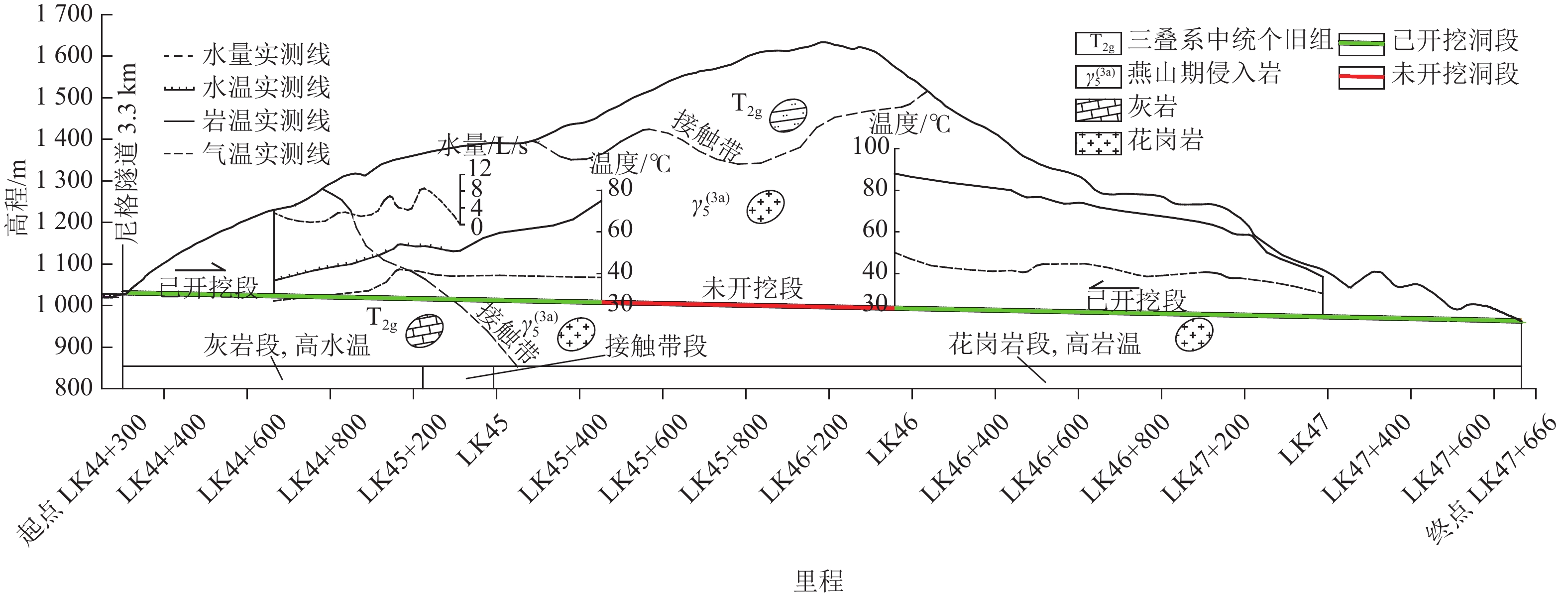
 下载:
下载:
